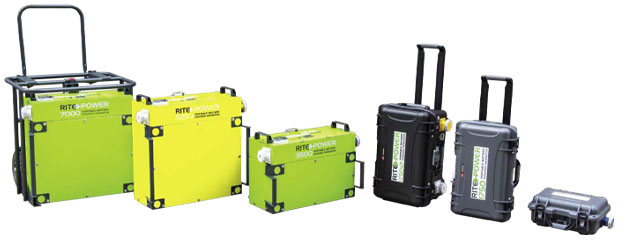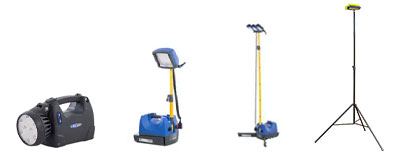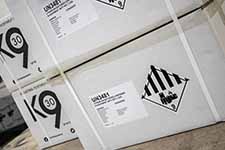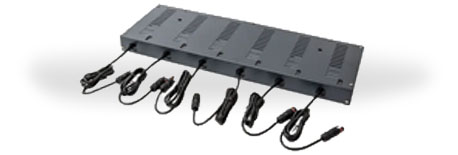LITHIUM BATTERY CARE
Lithium-ion (Li-ion) and Lithium Phosphate (LiFePo4) Batteries Storage, Use and Care
What are Li-ion and LiFePo4 batteries? What is the difference? How are they different to Sealed-Lead Acid batteries?
Historically people are used to Sealed-Lead acid (SLA) batteries. They have been used in many applications to power a wide range of products from small torches to large vehicles. SLA batteries have been a reliable source of power for many years.
Recent technological advancement has however, in recent years, enabled Lithium-ion (Li-ion) and Lithium Phosphate (LiFePo4) batteries to become a common replacement to the SLA battery. Lithium batteries have a higher energy density which enables them to store more power at lower weights. Lithium batteries also have increased charge cycles ensuring they will last many years longer than SLA batteries if used and stored correctly.
At Ritelite we have been developing lithium battery solutions for our key products for over 10 years and now primarily use both types of lithium batteries as the power source in all our portable lighting products and RITE-POWER battery generators.


Benefits of using Lithium batteries
How to transport Ritelite products containing Lithium batteries.
 All Ritelite products that are powered by lithium batteries have been designed to be used in tough working environments that customers need portable and mobile lighting for including railways, construction sites, remote working areas. The products are robust, strong and built to last. The batteries within these products are securely stored, protected and safe to transport, however there are some general and specific guidelines to follow when transporting Lithium batteries.
All Ritelite products that are powered by lithium batteries have been designed to be used in tough working environments that customers need portable and mobile lighting for including railways, construction sites, remote working areas. The products are robust, strong and built to last. The batteries within these products are securely stored, protected and safe to transport, however there are some general and specific guidelines to follow when transporting Lithium batteries.
General guidelines
- DO NOT expose any Lithium batteries to wet conditions or immerse in water or other liquids
- DO NOT crush, puncture, drop or disassemble batteries or products containing batteries
- DO NOT try to interconnect batteries
- DO NOT expose to temperatures above 60°C (140°F)
Specific transport regulations for Lithium batteries
When transporting by road within the UK by vehicle the driver should be aware that they are carrying products containing Lithium batteries. No specific licence is required under ADR regulations unless you are carrying a large weight – over 333kg of Lithium battery weight (batteries only not products as well). Products should be securely stored within a vehicle to prevent any movement when in transit.
 It is recommended that any driver carrying Lithium products keeps a 2kg dry power fire extinguisher in the car in case of a small engine fire to try and put the fire out (and prevent the Lithium batteries catching light). If there is any chance of the Lithium batteries catching fire the vehicle should be abandoned immediately and a cordon put in place with the emergency services informed as soon as possible.
It is recommended that any driver carrying Lithium products keeps a 2kg dry power fire extinguisher in the car in case of a small engine fire to try and put the fire out (and prevent the Lithium batteries catching light). If there is any chance of the Lithium batteries catching fire the vehicle should be abandoned immediately and a cordon put in place with the emergency services informed as soon as possible.
When transporting Lithium batteries or products containing Lithium batteries by airfreight IATA regulations would apply.
Our team is fully IATA trained for the safe transportation of Lithium batteries by air, hold multiple export qualifications and have many years experience in shipping Ritelite products worldwide. We are happy to help customer understand global shipping requirements and ensure your orders are delivered as quickly and smoothly as possible.
Always check all national and international regulations before transporting a product containing a Lithium battery outside the UK.
Transporting damaged or end of life batteries may be specifically limited or prohibited depending on country.

How to store Lithium batteries
 Recommended storage environment
Recommended storage environment
- Lithium batteries perform best if stored in a cool, dry, and well-ventilated area
- Recommended storage temperature 20°C ± 5°C (68°F ± 9°F)
- Minimum storage temperature: -20°C (-4°F)
- Maximum storage temperature: 35°C (-95°F)
- Avoid exposure to direct sunlight, moisture, or heat sources
- Store batteries in their original packing or a non-conductive, fireproof container
- Do not leave in a discharged state
- Keep away from strong acids and oxidizing agents
- Do not store near flammable materials
NOTE. Lithium batteries self-discharge during storage. Higher temperatures (above 20 °C or 68 °F) reduce the battery storage life.
To maintain battery life keep the product charged over 30% at all times, ideally at around 50% capacity. Lithium batteries slowly self-discharge when not in use or in storage so be sure to regularly check the battery’s charge status if storing for a long period of time.
What is the expected lifetime of a Lithium battery?
The expected lifetime of a Lithium-ion battery is between 300-800 cycles (a discharge and then a recharge) but this varies depending on depth of discharge and temperatures in use . Lithium phosphate (LiFePO4) batteries have a higher amount of charge cycles of 2500-5000 but are less energy dense than Lithium-Ion batteries.
NOTE. A Lithium battery will still work as it ages and the cycles increase but will show a reduction in performance as it gets towards its end of life.
A charge cycle is considered to start from the first use of the battery when fully charged right through until the battery is fully discharged and then fully recharged again. The less the battery is fully discharged and/or fully recharged will improve the number of cycles it achieves.
The average life of all Lithium batteries is, however, affected by a number of different factors including the depth of discharge before recharge and the environment it has been used in and good use and care of your battery will extend its lifetime.
- If possible, avoid deep discharge of battery i.e. recharge the battery after use rather than allowing the battery to run down to fully discharged before charging
- Only charge with the charger that the battery is supplied with. Recharge after every use (even partial use)
- Follow instructions on Storage/Charging/Discharging to maximise battery life
- Avoid high temperatures > 45 degrees °C + high humidity for maximised battery life
Customers should consider replacing a Lithium battery in a product when:
- The product run time drops regularly to below 80% of original run time
- Or the battery charge time increases significantly when used with same charger
If you would like to replace your Lithium battery in your Ritelite product please contact the Sales office on 01780 758585 for a quote
Please note that only replacement Lithium batteries supplied by Ritelite (Systems) Ltd will work with all Ritelite products.

How long does a Lithium battery take to charge?
The charge time will depend, as with all batteries, on the capacity of the battery and the charger that is being used.
It is important that all Ritelite products are ideally charged after use so they are ready for next time they are needed and regularly if not likely to be used for a long period of time to ensure the batteries always remain over 30% charged.
NOTE. Only Ritelite approved chargers should be used to charge Ritelite products and battery chemistries.
Ritelite has battery charging solutions offering a range of charge times to meet customers requirements. Our sales team will be happy to advise on the best charger for any product.
For all Lithium battery powered products it is important that they are not charged under 5 degrees celsius to prevent deterioration of battery life. Ideally batteries should be charged between 0°C and +40° C.
If the battery has been discharged in sub zero temperatures allow the battery to come back up to temperature before recharge.
Do not allow incorrect polarity during charging.
Recharge in a well-ventilated area.
Refer to charger user manual before first using.

Can I use a charger from another manufacturer to charge my Ritelite products?
Ritelite battery chargers are designed specifically to the products themselves with the correct software for charging and managing the battery to ensure optimum performance. Using a different charger from a different manufacturer could potentially reduce the life of your battery and cause other damage or even malfunctions so we would only recommend using the charger supplied by Ritelite with your Ritelite product. Ritelite has many charging solutions available to meet every requirement including vehicle chargers and multibank battery chargers to enable more than one battery to be charged at once from one mains plug socket.
Always follow the charging instructions provided with your product. Refer to your product’s user manual and/or contact the Ritelite technical team directly for more detailed information about charging any of the batteries that we supply.
Precautions to remember when using products containing Lithium batteries
 DO NOT short the battery terminals
DO NOT short the battery terminals- DO NOT reverse connections (polarity) from charger to battery
- DO NOT over charge or over discharge
- DO NOT operate battery beyond the published voltage, current and temperature limits
- DO NOT use if battery casing is cracked or damaged or batteries show any sign of swelling or smoking
- DO NOT immerse in any liquid
- DO NOT heat, incinerate, crush or dissemble
- DO NOT throw, hit or drop
- DO NOT use if there is any corrosion on electrical contacts
- DO NOT use if any cables or connectors are damaged

What happens if a Lithium battery is damaged?
 If you notice that the battery in your Ritelite product is damaged, has swelled up or is leaking action should be taken immediately.
If you notice that the battery in your Ritelite product is damaged, has swelled up or is leaking action should be taken immediately.
Avoid any direct contact with leaked electrolyte. Dispose of as below.
Prevent electrolyte spills from entering drains, soil or water sources.
PPE required when handling damaged or leaking batteries
Wear gloves to prevent skin irritation to hands. Wear chemical -resistant gloves (nitrile or butyl rubber) not latex gloves. If any skin comes into contact with leaked electrolyte immediately wash with water and remove contaminated clothing. Seek medical attention.
Wear chemical safety goggles or face shield. If you do come into contact with any fluid in your eyes do not rub eyes. Immediately flush eyes thoroughly with water for at least 15 minutes, lifting upper and lower lids, until no evidence of the fluid remains. Seek medical attention.
Wear long-sleeved protective clothing to prevent skin contact.
In the unlikely event of ingestion do not induce vomiting. Rinse mouth with plenty of water and seek immediate medical attention.
Thermal runway may occur if the battery is
- Exposed to temperatures exceeding 60°C
- Punctured
- Overcharged or short-circuited
- Battery failure under extreme conditions may lead to fire, release of toxic gases, or explosion
DO NOT dispose of Lithium batteries in general waste. Seek advice from your nearest specialised disposal centre at end of life.
Damaged batteries should not be touched with bare hands as electrolyte may leak out, causing skin irritation. Damaged batteries are best stored in a non-conductive container in a safe place outdoors, with the connection contacts taped over before being disposed of in line with local regulations.
The disposal and recycling regulations vary by country and region.
